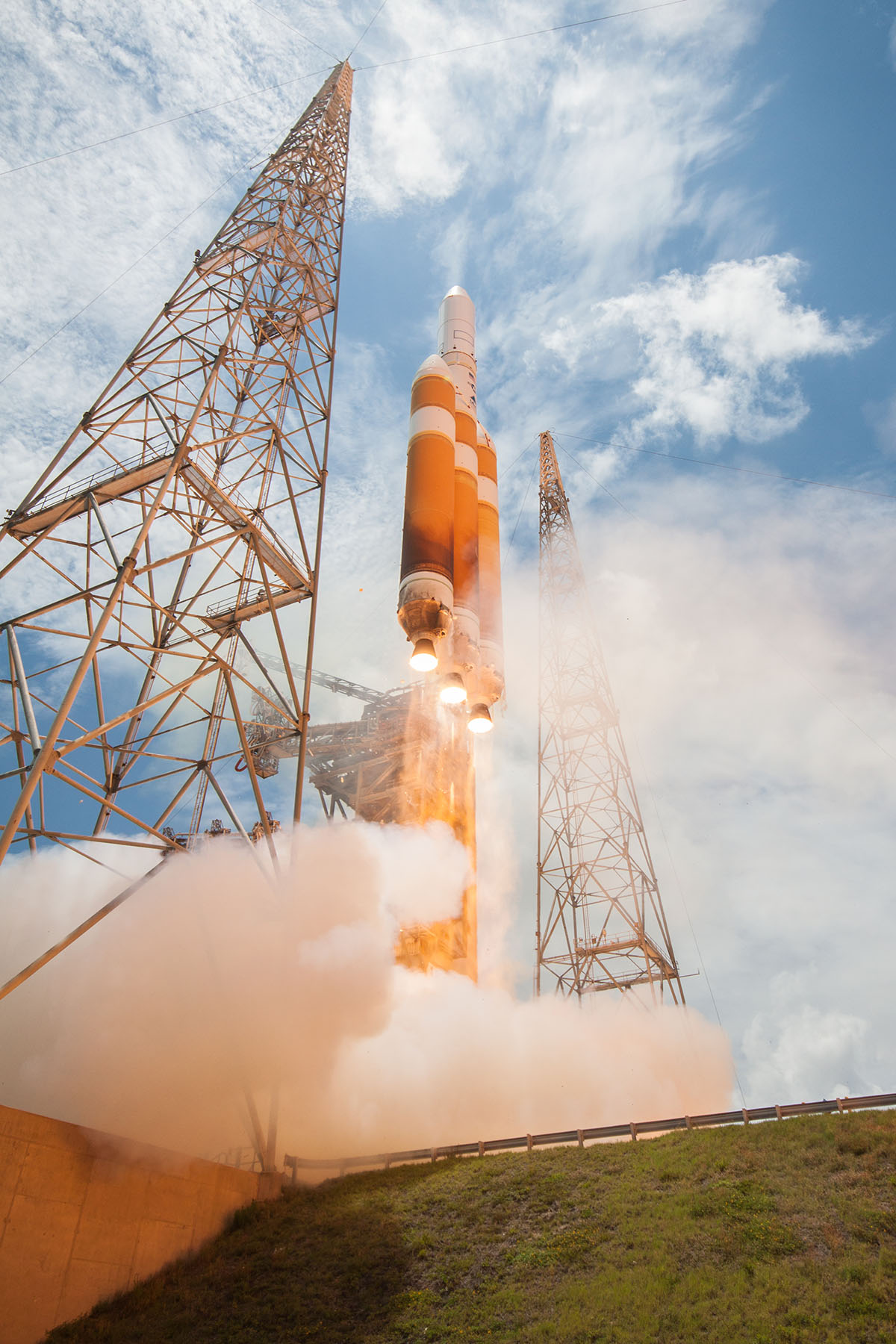Delta IV Heavy: Powerful Launch Vehicle

The Delta IV Heavy is a variant of the Delta IV line. Until recently, it was the world's most powerful operational launch vehicle in terms of launch mass. While the majority of its work is for the defense market, it is also known in space circles for successfully launching the Orion spacecraft on a test flight in December 2014. Delta IV Heavy will also launch the Parker Solar Probe in 2018.
The Delta IV line of rockets was created by McDonnell-Douglas (later part of Boeing) and is manufactured today by United Launch Alliance. The Delta IV has multiple variants, including a Delta IV Medium and three Delta IV Medium+ variants. The Medium hasn't flown since 2006. In 2015, United Launch Alliance said it would retire all of the Medium+ configurations in 2018 or 2019 due to increased cost of the launch system, compared to the competition, according to Spaceflight Insider. The Delta Heavy is expected to remain in service for at least a while, into the 2020s.
Basic specs
Height: 232 feet (70.7 meters)
Stages: 2 — a first stage core booster and a cryogenic second stage. It includes two additional core boosters as strap-on liquid rocket boosters, to increase launch capacity.
Payload to geostationary transfer orbit: 30,440 lbs. (13,810 kilograms)
Payload to low Earth orbit: 62,540 lbs. (28,370 kg)
SpaceX's Falcon Heavy surpassed the Delta IV Heavy as the most powerful operational launch vehicle in terms of launch mass after a successful test flight in February 2018.
Breaking space news, the latest updates on rocket launches, skywatching events and more!
Launch history
The first launch of a Delta IV Heavy rocket was on Dec. 21, 2004, from Cape Canaveral Air Force Station near Orlando, Fla. The demonstration did not go exactly as planned. A flaw in the core booster strap-ons caused the demonstration satellite, called DemoSat, to reach the incorrect orbit. Two smaller satellites called 3CS-1 and 3CS-2 did not reach their intended orbit at all.
The next launch on Nov. 11, 2007, went as planned, as the rocket launched a missile-warning satellite. However, the launch date was delayed after the pad was damaged by a liquid oxygen leak. The Delta IV Heavy then successfully lobbed reconnaissance satellites into orbit in January 2009, November 2010 and January 2011.
In June 2012, a Delta IV Heavy made a successful launch of a reconnaissance satellite, while using the RS-68A engine for the first time. Another successful reconnaissance launch took place in August 2013.
Delta IV Heavy broke out of the military satellite market on Dec. 5, 2014, when it sent the uncrewed Orion spacecraft into space. The spacecraft flew higher and faster than any other spacecraft designed for humans since the Apollo 17 spaceflight in December 1972. The Delta IV Heavy's second stage brought Orion to an altitude of 3,600 miles (5,793 km), 14 times higher than the orbit of the International Space Station. The test was deemed a success and the next test flight of Orion is expected to take place on NASA's Space Launch System.
The rocket followed up this historic flight with another reconnaissance satellite launch on June 11, 2016. Its next planned launch will take place no earlier than July 31, 2018, when Delta IV Heavy lofts the Parker Solar Probe into space. This mission will approach the sun at close proximity (4 million miles or 6.4 million kilometers) to learn more about space weather, after flying by Venus seven times and reaching an orbit that will bring it far closer to the sun than Mercury.
Future of Delta IV Heavy
The future of the Delta IV Heavy in the military market may change, as the Falcon Heavy can loft heavy satellites at what may be a lower cost. In Ars Technica, it was reported in February 2018 that the Falcon Heavy rocket costs $90 million per launch, compared to at least $350 million per launch for the Delta IV. That makes Delta IV nearly four times as expensive as Falcon Heavy, depending on how the cost is calculated.
The U.S. government currently has an exclusive contract with ULA that is expected to phase out in 2019 (for Atlas rockets) and 2020 (for Delta rockets). The $350 million figure does not include the value of this contract, which is valued at $1 billion annually. Ars Technica predicts that once the contract ceases, Delta IV Heavy launches will cost north of $600 million each in the early 2020s.
While the cost of Delta IV Heavy is much higher, the rocket also has a perfect record since its initial partial launch failure in December 2004. The Falcon Heavy has only had a single test flight, but it is expected to fly twice more in 2018. Cost and reliability will both come under consideration as the U.S. government considers its options for the contract renewal.
Additional resources

Elizabeth Howell (she/her), Ph.D., was a staff writer in the spaceflight channel between 2022 and 2024 specializing in Canadian space news. She was contributing writer for Space.com for 10 years from 2012 to 2024. Elizabeth's reporting includes multiple exclusives with the White House, leading world coverage about a lost-and-found space tomato on the International Space Station, witnessing five human spaceflight launches on two continents, flying parabolic, working inside a spacesuit, and participating in a simulated Mars mission. Her latest book, "Why Am I Taller?" (ECW Press, 2022) is co-written with astronaut Dave Williams.
